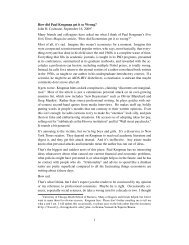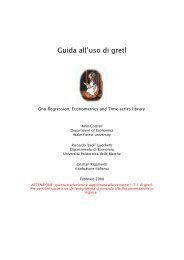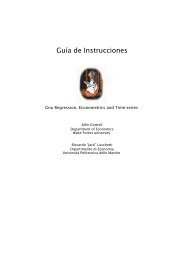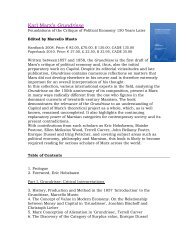The Labor Market of the Early Roman Empire - Wake Forest University
The Labor Market of the Early Roman Empire - Wake Forest University
The Labor Market of the Early Roman Empire - Wake Forest University
You also want an ePaper? Increase the reach of your titles
YUMPU automatically turns print PDFs into web optimized ePapers that Google loves.
518 | PETER TEMIN<br />
Steinfeld’s scenario is <strong>the</strong> standard against which to evaluate<br />
<strong>Roman</strong> labor markets. Wages were an important tool for <strong>the</strong> allocation<br />
<strong>of</strong> labor in eighteenth-century England, but <strong>the</strong>ir use was<br />
limited by <strong>the</strong> restrictions on labor mobility. Wages in such a system<br />
would not reach equality for similar skills, and most workers<br />
would not feel free to look around for a more lucrative activity.<br />
Free urban workers in <strong>the</strong> early <strong>Roman</strong> empire were paid for<br />
<strong>the</strong>ir work and were able to change <strong>the</strong>ir economic activities. Hereditary<br />
barriers were nonexistent, and <strong>Roman</strong> guilds do not appear<br />
to have been restrictive. Workers in large enterprises, like<br />
mines and galleys, were paid wages, as in more modern labor markets.<br />
Workers engaged in more skilled and complex tasks received<br />
more elaborate compensation, probably for longer units <strong>of</strong> time<br />
than those doing wage labor, again as in more modern labor markets,<br />
even though explicit long-term contracts were not yet established.<br />
<strong>The</strong> force <strong>of</strong> competition under those circumstances<br />
probably brought wages and labor productivity into <strong>the</strong> same ballpark.<br />
8<br />
Some <strong>of</strong> <strong>the</strong> work in <strong>the</strong> early <strong>Roman</strong> empire was done for<br />
wages and some under <strong>the</strong> duress <strong>of</strong> slavery. <strong>The</strong> early <strong>Roman</strong><br />
empire even had salaried long-term free workers in Egypt. Craftsmen<br />
sold <strong>the</strong>ir wares in cities and also supplied <strong>the</strong>m to rural and<br />
urban patrons in return for long-term economic and social support.<br />
Similarly, people who worked for, or supplied, senators and<br />
equestrians <strong>of</strong>ten worked for long-term rewards and advancement.<br />
<strong>The</strong> episodic nature <strong>of</strong> monumental building in Rome, accomplished<br />
largely by free laborers, gives evidence <strong>of</strong> a mobile labor<br />
force that could be diverted from one activity to ano<strong>the</strong>r. Free<br />
workers, freedmen, and slaves worked in all kinds <strong>of</strong> activities;<br />
contemporaries saw <strong>the</strong> ranges <strong>of</strong> jobs and <strong>of</strong> freedom as sepa-<br />
Price Formation in <strong>Roman</strong> Egypt,” Economie antique: Prix et formatin des prix dans les economies<br />
antiques (Saint-Bertrand-de-Comminges, 1997), 183–244; Temin, “A <strong>Market</strong> Economy in <strong>the</strong><br />
<strong>Early</strong> <strong>Roman</strong> <strong>Empire</strong>,” Journal <strong>of</strong> <strong>Roman</strong> Studies, XCI (2001), 169–181; Robert J. Steinfeld,<br />
<strong>The</strong> Invention <strong>of</strong> Free <strong>Labor</strong>: <strong>The</strong> Employment Relation in English and American Law and Culture,<br />
1350–1879 (Chapel Hill, 1991), 26. See also idem, Coercion, Contract and Free <strong>Labor</strong> in <strong>the</strong> Nineteenth<br />
Century (Cambridge, 2001). <strong>Labor</strong> mobility was reduced fur<strong>the</strong>r in continental Europe<br />
by guilds and o<strong>the</strong>r restrictions. See Sheilagh Ogilvie, State Corporatism and Proto-Industry: <strong>The</strong><br />
Württemberg Black <strong>Forest</strong>, 1580–1797 (Cambridge, 1997), for a description <strong>of</strong> labor conditions in<br />
early Germany.<br />
8 Tenney Frank, Economic Survey <strong>of</strong> Ancient Rome (1940), V, 248–252; Russell Meiggs, <strong>Roman</strong><br />
Ostia (Oxford, 1973), 314.







